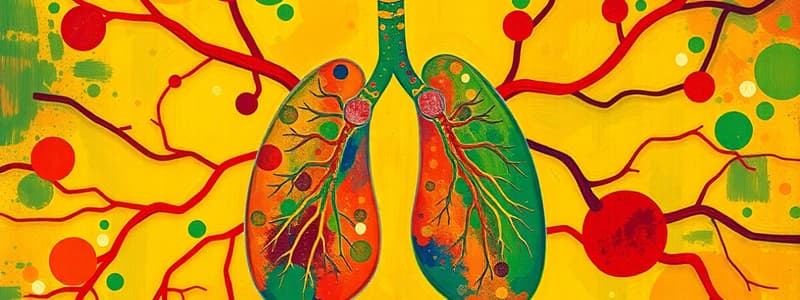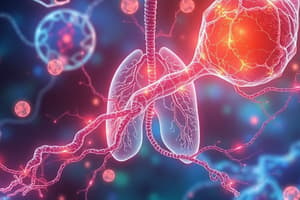Podcast
Questions and Answers
What is the primary purpose of cellular respiration?
What is the primary purpose of cellular respiration?
- To synthesize glucose for cellular activities
- To acquire chemical energy from food (correct)
- To provide nutrients to all cells
- To store energy in the form of glycogen
Where in eukaryotic cells does most cellular respiration occur?
Where in eukaryotic cells does most cellular respiration occur?
- On the cell membrane
- In the cytoplasm
- In the mitochondria (correct)
- In the nucleus
What distinguishes aerobic cellular respiration from anaerobic cellular respiration?
What distinguishes aerobic cellular respiration from anaerobic cellular respiration?
- Anaerobic respiration is more efficient than aerobic respiration
- Aerobic respiration occurs in prokaryotic cells only
- Both processes output the same amount of ATP
- Aerobic respiration requires oxygen while anaerobic does not (correct)
What molecule is typically used as the main fuel source in cellular respiration?
What molecule is typically used as the main fuel source in cellular respiration?
During which stage of cellular respiration is energy most efficiently produced?
During which stage of cellular respiration is energy most efficiently produced?
What is the main purpose of glycolysis in aerobic cellular respiration?
What is the main purpose of glycolysis in aerobic cellular respiration?
Which stage of aerobic respiration produces carbon dioxide and acetyl-CoA?
Which stage of aerobic respiration produces carbon dioxide and acetyl-CoA?
What role does oxygen play in the electron transport chain?
What role does oxygen play in the electron transport chain?
Which of the following statements is true about anaerobic respiration?
Which of the following statements is true about anaerobic respiration?
What is the main product of oxidative phosphorylation?
What is the main product of oxidative phosphorylation?
In glycolysis, what is produced alongside pyruvate?
In glycolysis, what is produced alongside pyruvate?
Which of the following processes directly precedes the Krebs cycle?
Which of the following processes directly precedes the Krebs cycle?
What happens to the electrons from NADH and FADH2 during oxidative phosphorylation?
What happens to the electrons from NADH and FADH2 during oxidative phosphorylation?
What is the metabolic process by which cells acquire energy from food called?
What is the metabolic process by which cells acquire energy from food called?
What is primarily produced as a result of cellular respiration?
What is primarily produced as a result of cellular respiration?
How do aerobic and anaerobic respiration differ?
How do aerobic and anaerobic respiration differ?
In which organelle does cellular respiration primarily occur in eukaryotic cells?
In which organelle does cellular respiration primarily occur in eukaryotic cells?
What type of respiration occurs when cells break down glucose without the use of oxygen?
What type of respiration occurs when cells break down glucose without the use of oxygen?
What are the starting materials for glycolysis?
What are the starting materials for glycolysis?
What is the primary end product of the Krebs cycle for each glucose molecule processed?
What is the primary end product of the Krebs cycle for each glucose molecule processed?
What is the role of coenzyme A in cellular respiration?
What is the role of coenzyme A in cellular respiration?
Which stage of aerobic respiration uses NADH and FADH2 to produce ATP?
Which stage of aerobic respiration uses NADH and FADH2 to produce ATP?
What byproduct is produced during lactic fermentation in mammalian cells?
What byproduct is produced during lactic fermentation in mammalian cells?
Which of the following statements accurately describes oxidative phosphorylation?
Which of the following statements accurately describes oxidative phosphorylation?
During glycolysis, how many net ATP molecules are produced?
During glycolysis, how many net ATP molecules are produced?
What is the final electron acceptor in the electron transport chain?
What is the final electron acceptor in the electron transport chain?
What is produced in the formation of acetyl-CoA from pyruvate?
What is produced in the formation of acetyl-CoA from pyruvate?
What overall amount of ATP can be generated from the breakdown of one glucose molecule during aerobic respiration?
What overall amount of ATP can be generated from the breakdown of one glucose molecule during aerobic respiration?
Flashcards are hidden until you start studying
Study Notes
Cellular Respiration
- Cellular respiration is the process by which living cells acquire chemical energy from food molecules, like glucose.
- Cells use the energy from cellular respiration to survive and perform their normal activities.
- Mitochondria are organelles responsible for energy production in eukaryotic cells.
- Glucose is the typical fuel source for cellular respiration and is broken down through a series of steps to extract energy in the form of adenosine triphosphate (ATP).
Stages of Cellular Respiration
- Aerobic respiration: Occurs in the presence of oxygen.
- Anaerobic respiration: Occurs in the absence of oxygen.
Aerobic Respiration
- Occurs in three stages: glycolysis, Krebs cycle (citric acid cycle), and oxidative phosphorylation.
- Glycolysis: Breaks down glucose into two pyruvate molecules, produces ATP and carbon dioxide.
- Occurs in the cytoplasm of the cell.
- Does not require oxygen.
- Produces two ATP, two NADH, and two pyruvate molecules.
- Transition Reaction/Bridge Reaction/Formation of Acetyl CoA: Converts pyruvate to acetyl-CoA, liberates carbon dioxide, and transfers hydrogen atoms to NAD+.
- Occurs in the mitochondria.
- Produces acetyl-CoA, carbon dioxide, and NADH.
- Krebs Cycle/Citric Acid Cycle: Breaks down acetyl-CoA into carbon dioxide, produces ATP, and transfers hydrogen atoms to NAD+ and FAD.
- Occurs in the mitochondria.
- Produces 6 carbon dioxide, 8 NADH, 2 FADH2, and 2 ATP.
- Oxidative Phosphorylation: Uses NADH and FADH2 to produce a large number of ATP molecules.
- Occurs in the mitochondria.
- Consists of the electron transport chain and chemiosmosis.
- Requires oxygen as the final electron acceptor.
- Produces ~32 ATP, NAD+, FAD, and water.
Anaerobic Respiration
- Fermentation: Occurs after glycolysis in anaerobic organisms.
- Produces small amounts of ATP through substrate-level phosphorylation.
- Produces either lactic acid (lactic fermentation, in mammalian cells) or ethanol (alcohol fermentation, in yeast).
- Other Anaerobic Respiration Processes: Similar to aerobic respiration, but uses a molecule other than oxygen, such as sulfur, as the final electron acceptor.
Importance of Cellular Respiration
- It is essential for life as it provides cells with energy in the form of ATP.
- Cellular respiration is a common process in all living organisms, whether aerobic or anaerobic.
Cellular Respiration Reactants and Products
- Reactants: Food energy molecule (e.g., glucose) and oxygen (for aerobic respiration).
- Products: ATP, water, and carbon dioxide (for aerobic respiration).
Equation for Aerobic Cellular Respiration
- Glucose + oxygen --> carbon dioxide + water + ATP
What is Cellular Respiration?
- Cellular respiration is the process by which living cells acquire energy from food molecules.
- This energy is stored as ATP (adenosine triphosphate) and used to fuel various cellular processes.
Where does Cellular Respiration Take Place?
- In eukaryotic cells, the mitochondria is the primary site for cellular respiration.
- The breakdown of food molecules into ATP can occur with or without oxygen.
Stages of Cellular Respiration
- There are two major types of cellular respiration: aerobic and anaerobic.
- Aerobic respiration requires oxygen and produces more ATP than anaerobic respiration.
- Anaerobic respiration occurs in the absence of oxygen and produces less ATP.
Stages of Aerobic Respiration
- Glycolysis:
- Occurs in the cytoplasm.
- Breaks down glucose into two pyruvate molecules.
- Produces 2 net ATP and 2 NADH.
- Transition Reaction:
- Occurs in the mitochondria.
- Converts pyruvate into acetyl-CoA.
- Produces 1 NADH per pyruvate molecule.
- Krebs Cycle (Citric Acid Cycle):
- Occurs in the mitochondria.
- Oxidizes acetyl-CoA, producing carbon dioxide, ATP, NADH, and FADH2.
- Oxidative Phosphorylation:
- Occurs in the mitochondria.
- Involves the electron transport chain and chemiosmosis.
- Uses NADH and FADH2 to generate a proton gradient, which drives ATP synthesis.
- Produces a significant amount of ATP (approximately 32 ATP per glucose molecule).
Anaerobic Respiration Processes
- Fermentation:
- Occurs in the absence of oxygen.
- Follows glycolysis.
- Produces small amounts of ATP and byproducts such as lactic acid (lactic fermentation) or ethanol (alcoholic fermentation).
- Anaerobic Cellular Respiration:
- Similar to aerobic respiration, but uses a molecule other than oxygen as the final electron acceptor.
- Examples include sulfur-based respiration.
Importance of Cellular Respiration
- Cellular respiration is essential for life.
- It provides the ATP energy necessary for cellular functions.
- Both anaerobic and aerobic respiration processes involve the breakdown of food molecules to generate ATP.
Reactants and Products of Cellular Respiration
- Reactants:
- Glucose
- Oxygen (aerobic respiration)
- Other electron acceptors (anaerobic respiration)
- Products:
- ATP
- Water (aerobic respiration)
- Carbon dioxide (aerobic respiration)
- Variable metabolic waste products (depending on the type of anaerobic respiration)
Studying That Suits You
Use AI to generate personalized quizzes and flashcards to suit your learning preferences.




